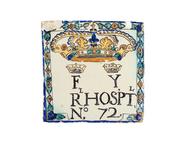





Tin glazed earthenware albarello, polychrome decoration, labelled "VGTO.D.EGIPTIACO", Egyptian ointment, possibly from Castelli, Italian, 1585
The Italian inscription painted on to this earthenware jar VNGTO.D.EGIPTIACO translates as “Egyptian ointment”. It consists of two parts honey and one part vinegar, with a good dose of verdigris – the green layer that forms on copper – added in. The mixture was then heated. Once cooled, it could be applied to treat a number of skin complaints, including ulcers. It is thought the ointment was either invented in Egypt or was popular there, giving the mixture its name.
Details
- Category:
- Medical Ceramic-ware
- Collection:
- Sir Henry Wellcome's Museum Collection
- Object Number:
- A43260
- Materials:
- earthenware (tin glazed)
- Measurements:
-
overall: 193 mm 140 mm, .73kg
- type:
- albarello
- credit:
- Sotheby's



